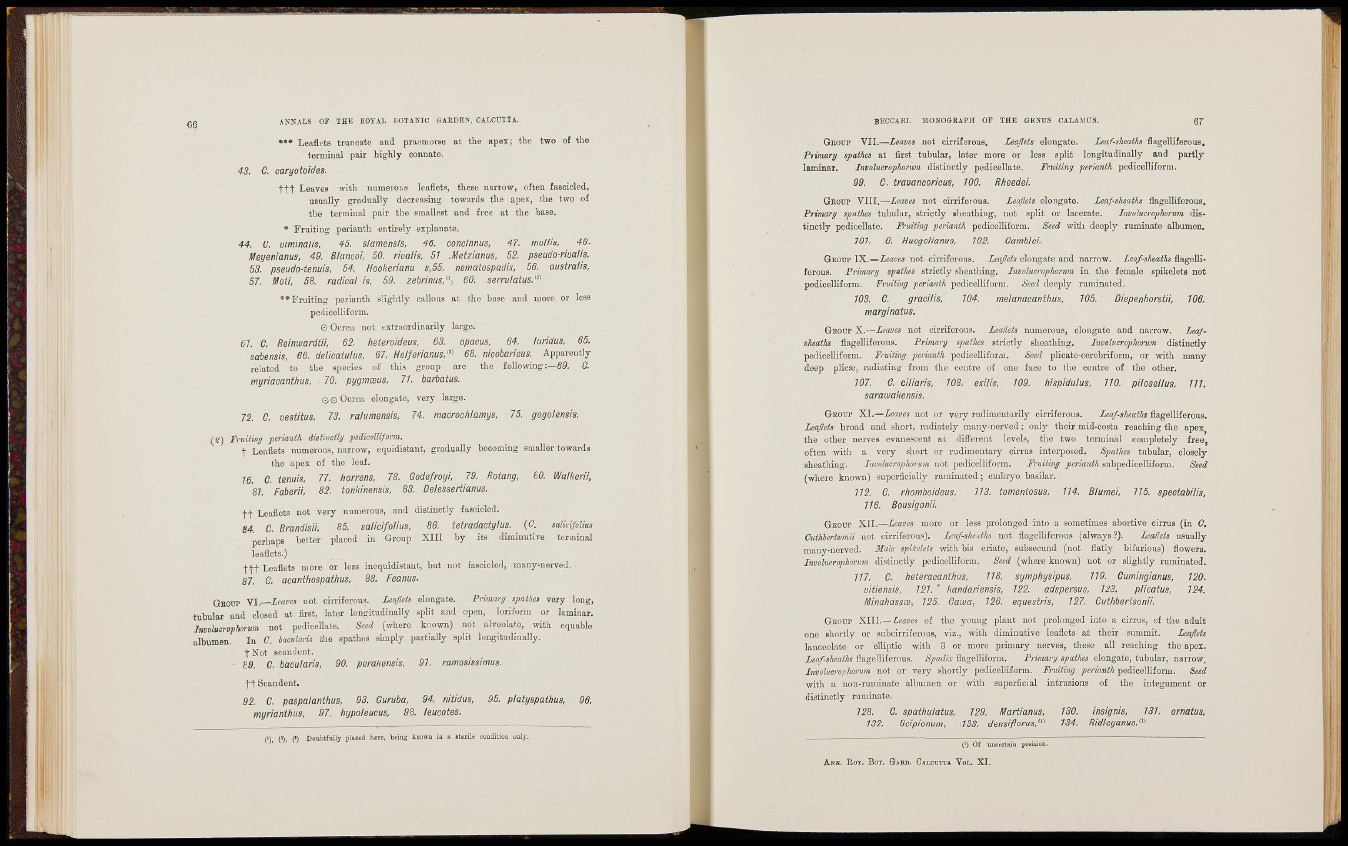
^ g ANNALS OP THE BOTAL I50TANIC GAUDEN, CALCUTTA.
Leafluts truncate and praomorse at the apox; tbc two of the
terminal pair highly connate.
43. C. caryotoides.
t t t Leaves with numeroiiS leaflets, these nnrrow, often faaeicled,
usually gradually decreasing towards the apox, the two of
the terminal pair the smallest and free at the base.
• Fruiting perianth entirely explanate.
44. C. viminatis, 45. siamensis, 46. concinnus, 47. mollis, 48-
Meyenianus, 49. Blancoi, 50. rival is, 57 .Metzianus, 52. pseudo-riuaHs,
58. pseudo-tenuis, 54. Hookemm s,55. nematospadix, 56. australis,
57. Moti, 58. radical is, 59. zebrinus,'\ 60. serrulatus.'^^
**l'ruiting perianth slightly callous at the base and roore or less
pedicelliform.
© Ocrea not extraordinarily large.
61. C. Reinwardtii, 62. heteroideus, 63. opacus, 64. luridus, 65.
sabensis, 66. delicatulus, 67. Helferiams,"-^^ 68. nicobancus. Apparently
related to the species oi this group are the f o l l o w i n g : — G.
myriacanthus, 70. pygmceus, 71. barbatus.
OOOcrca elongate, very large.
72. 0. uestitus, 73. ralumensis, 74. macrochlamys. 75. gogolensis.
(g) Fruitinff perianth distivcthj pedicelliform.
t Leaflets numerous, narrow, ei^uidistant, gradually becoming smaller towards
the apex of the leaf.
16. G. tenuis, 77. horrens, 78. Godefroyi, 79. Rotang, SO. Walkerii,
81 Faberii, 82. tonkinensis, 83. Delessertianus.
f t Leaflets not very numerous, and distinctly fascicled.
84. C. Brandisii, 85. salicifolius, 86. tetradaotylus. (G. salid/olius
perhaps better placed in Group XIII by its diminutive tor.iiinal
leaflets.)
t t t Leaflets more or less inequidistant, but not fascicledj many-nerved.
87. C. aeanthospathus, 88. Feanus.
GROUP 'VI.—Leaves not cirriferous. Leaflets elongate. Primary spathes very loDg,
tubular and closed at first, later longitudinally split and open, loriforui or laminar.
Involumplionm not pedicellate. Seed (where known) not alveolate, with equable
albumen. In G. bactdaris che spathes simply partially split longitudinally.
t Not Bcandent.
- 89. C. bacularis, 90. perahensis, 91. ramosiasimus.
t t S c a n d e n t .
92. G. paspalanthus, 93. Guruba, 94. nitidus, 95. platyspathus, 96.
myrianthus, 97. hypoleucus, 98. leucotes.
('). ('). (') Doubtfully placed here, teing known ia a sttrile condition only.
BECCARI. JIONOGEAPII OF THE GENUS CALAMUS. 07
GROUP VII.—Leaves not cirriferous. Leaflets elongate. Leaf-sheaihs flagelliferous.
Primary spathes at first tubular, later more or less split longitudinally and partly
laminar. Involuerophonm distinctly pedicellate, Fruiting perianih pedicelliform.
99. G. trauancorious, 100. Rheedei.
GROUP VIII.—Leaves not cirriferous. Leaflets elongate. Leaf-sheaths fiagelliferous.
Primary spathes tubular, strictly sheathing, not split or lacerate. Involucrophortm distinctly
pedicellate, Fi'uiting perianth pcdicclliform. Seed with deeply ruminate albumen.
101. G. Huegelianus, 102. Gamble!.
GROUP IX.—Leaves not cirriferous. Leaflets elongate and narrow. Leaf-sheaths flagelliforous.
Primary spathes strictly sheathing. Involuorophorum in tho female spikelets not
pedicelliform. Fruiting -perianth pedicelliform. Seed deeply ruminated.
103_. C. gracilis, 104. melanacanthus, 105. Diepenhorstii, 106.
marginatus.
GROUP X..—Leaves not cirriferous. Leaflets nmnerous, elongate and narrow. Leafsheaths
flagelliferous. Primary spathes stiictly sheathing. Involucrophonm distinctly
pedicelliform. Fruiting perianth pedicelliform. Seed plicate-cerebrifonn, or -with many
deep plica3, radiating from the centre of one face to the centre of the other.
107. G. ciliaris, 108. exilis, 109. hispidulus, 110. pilose!I us, 111.
sarawakensis.
GROUP XI.—Leaves not or very riidimentarily cirriferous. Leaf-sheaths f
Leaflets broad and short, radiately many-nerved; only their mid-costa reaching tho ;
the other nerves evanescent at different levels, the two tei-minal completely free',
often with a very short or rudimentary cii-rus interjjosed. Spathes tubular, closely
sheathing. Involucrophoram not pedicelliform. Fi'uiting perianth subpedicelliform. Seed
(where known) superficially ruminated; embryo basilar.
112. G. rhomboideus, 113. tomentosus, 114. Blumei, 115. spectabHis,
116. BousigonH,
GROUP XII.—Leaves more or less prolonged into a sometimes abortive CIITUS (in C.
CutUerisonii not cirriferous). Leaf-sheaths not flagelliferous (always?). Leaflets usually
many-nerved. Male spikelets \vith bis eriate, subsecund (not flatly bifarious) flowers.
Imohsrophorum distinctly pedicollifoi-m. Seed (where known) not or slightly ruminated.
117. C. heteracantfius, 118. symphyslpus, 119. Cumingianus, 120.
uitiensis, 121. ' kandariensis, 122. adspersus, 123. plicatus, 124.
Minahassce, 125. Gauia, 126. equestris, 127. Cuthbertsonii.
GROUP X l l i . —¿EARN of the young plant not prolonged into a cirrus, of the adult
one shortly or subcirrit'crous, viz., with diminutive leaflets at their smnmit. Leaflets
lanceolate or elliptic with 3 or more primary nerves, these all reaching the apex.
Leaf-sheaths flagelliferous. Spadix flagelliform. Primary spathes elongate, tubular, narrow.
Involucrophonm not or very shortly pedicelliform. Fruititig perianth pedicellifonn. Seed
with a non-ruminate albumen or .with superflcial iutrusiona of the integument or
distinctly ruminate.
128. G. spathulatus, 129. Martianus, 130. insignis, 131. ornatus,
132. Scipionum, .133. densiflorus,^'^ 134. Ridleyanus.^'>
(') Of uncertain positioo.
ANN. HOT. BOT. GARD, CALCUTTA VOL. X I .